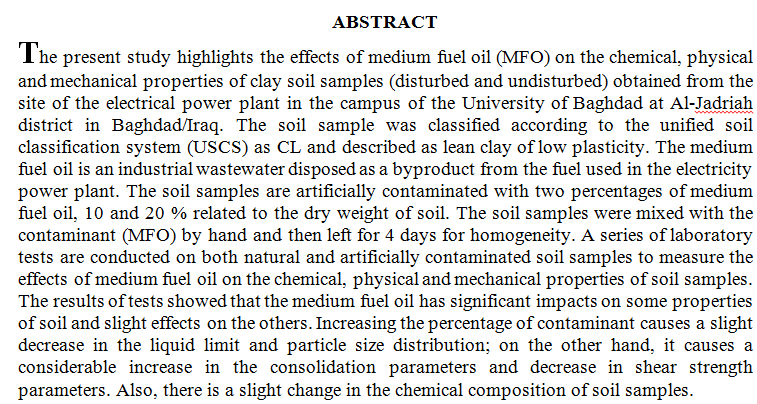
Chitosan (CH) / Poly (1-vinylpyrrolidone-co-vinyl acetate) (PVP-co-VAc) blend (1:1) and nanocomposites reinforced with CaCO3 nanoparticles were prepared by solution casting method. FTIR analysis, tensile strength, Elongation, Young modulus, Thermal conductivity, water absorption and Antibacterial properties were studied for blend and nanocomposites. The tensile results show that the tensile strength and Young’s modulus of the nanocomposites were enhanced compared with polymer blend [CH/(PVP-co-VAc)] film. The mechanical properties of the polymer blend were improved by the addition of CaCO3 with significant increases in Young’s modulus (from 1787 MPa to ~7238 MPa) and tensile strength (from 47.87 MPa to 79.75 MPa). Strong interfacial
... Show MoreThe placement of buildings and structures on/or adjacent to slopes is possible, but this poses a danger to the structure due to failures that occur in slopes. Therefore, a solution or improvement should be determined for these issues of the collapse of the structure as a result of the failure of the slopes. A laboratory model has been built to test the impact of some variables on the bearing capacity factor. The variables include the magnitude of static axial load applied at the center of footing, the depth of embedment, the spacing between geogrid reinforcement layer and the numbering of the geogrid sheet under the footing, the inclination angle of slope clayey soil (β), the spacing between the footing's edge and the slope's end (b/H). Th
... Show MoreCyanobacteria are prokaryotic photosynthetic communities which are used in biofertilization of many plants especially rice plant. Cyanobacteria play a vital role to increase the plant's ability for salinity tolerance. Salinity is a worldwide problem which affects the growth and productivity of crops. In this work three cyanobacteria strains (Nostoc calcicola, Anabaena variabilis, and Nostoc linkia) were isolated from saline soil at Kafr El-Sheikh Governorate; North Egypt. The propagated cyanobacteria strains were used to withstand salinity of the soil and increase rice plant growth (Giza 178). The length of roots and shoot seedlings was measured for seven and forty days of cultivation, respectively. The results of this investigation showed
... Show More (13)
(13)
 (12)
(12)
 (4)
(4)
 (2)
(2)
 (2)
(2)
 (1)
(1)
In vivo study revealed that ZnO nanoparticles treatment of Streptococcus SPP contaminated injured skin showed good prognosis and good healing process include complete regeneration of the epithelial cells of the epidermis and increase of cellulartiy of the dermal content compared with untreated group. In conclusion, treatment of S. pyogenes infected skin with Zinc oxide nanoparticles concentration (2 mg/ml) limit the skin damage and localized the lesion to the incision site with good healing process
 (9)
(9)
 (7)
(7)
The possible effects of COVID-19 vaccines on reproductive health and male fertility in particular have been discussed intensely by the scientific community and the public since their introduction during the pandemic. On news outlets and social media platforms, many claims have been raised regarding the deleterious effects of COVID-19 vaccines on sperm quality without scientific evidence. In response to this emerging conflict, we designed this study to evaluate and assess the effect of the Pfizer-BioNTech mRNA COVID-19 vaccine on male fertility represented by the semen analysis parameters.
... Show More (18)
(18)
 (16)
(16)
Anabolic androgenic steroids (AAS) are man-made derivatives of the male sex hormone testosterone, originally designed for therapeutic uses to provide higher anabolic potency with lower androgenic effects. Increasing numbers of young athletes are using these agents illicitly to enhance physical fitness, appearance, and performance despite their numerous side effects and worldwide banning. Today, their use remains one of the main health problems in sports because of their availability and low price. The present study focuses on investigating the adverse effects of anabolic androgenic steroid abuse on sex hormones, liver and renal function tests, fasting glucose levels and lipid metabolism in Iraqi male recreational bodybuilders
... Show More (1)
(1)
